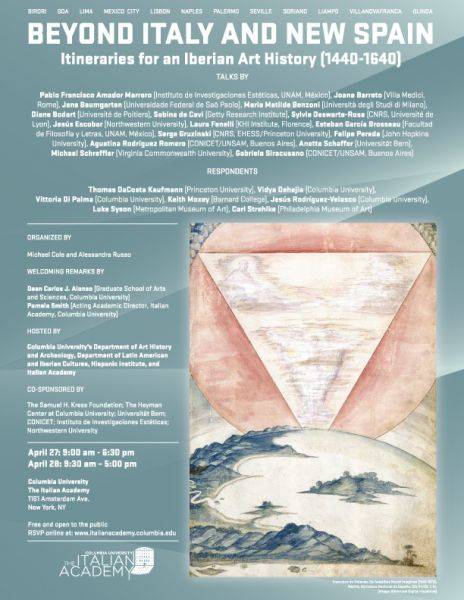International Conference "Beyond Italy and New Spain"
This conference aims to open new dialogues on Iberian art and architecture from the decade that saw the Aragonese conquest of Southern Italy (1443) and the establishment of the first Portuguese trading station on the African island of Arguim (1449) to that of the separation of the Portuguese and the Spanish crowns (1640).
The two organizers — Michael Cole and Alessandra Russo — focus on different geographical areas and were motivated to undertake this project by a shared awareness of the fragmentation that currently characterizes a major field of art history — the study of sixteenth-century Iberian art and architecture. One of us started from a perspective on what is now the country of Italy, but which in the sixteenth-century belonged largely to Spain: the entire south, divided between the Kingdoms of Naples and Sicily, was ruled by Spanish viceroys; the Duchy of Milan had governors appointed by Spain; territories from the Republic of Genoa to the city-states of the northeast were essentially Spanish dependences. The other confronted the anachronistically national point of view that often guides the study of "Mexican," "Peruvian," "Brazilian" or "Indian" art history, when in fact these territories were under the Spanish and the Portuguese crowns. Referring to these territories as "colonial" possessions is equally unhelpful for conceiving them in a larger and more dynamic frame — what we call the "Iberian" atlas, which encompassed not only large parts of America, Africa and Asia, but also broad regions within Europe itself.
The participants in the conference will discuss artistic dynamics in or between at least two zones of the Iberian atlas (Portugal, Brazil, Flanders, Spain, Goa, Macao, Milan, Naples, Peru, the Philippines, Sicily, Sierra Leone, etc.). Themes will include the movement, reinstallation, and reinterpretation of images and objects; the materials of art making and their changing (or unchanging) meaning; printed and other reproductions and their relationship to new originals; the reinterpretation of architectural models in response to differing landscapes, labor conditions, technologies, and functional requirements; the travel of artists, patrons, and viewers; competing religious, political, intellectual, or patronage networks (Jesuits vs Franciscans, traders vs missionaries, Portuguese vs Dutch, etc.); the literature of art and its forms across space.


































i-Italy
Facebook
Google+
This work may not be reproduced, in whole or in part, without prior written permission.
Questo lavoro non può essere riprodotto, in tutto o in parte, senza permesso scritto.